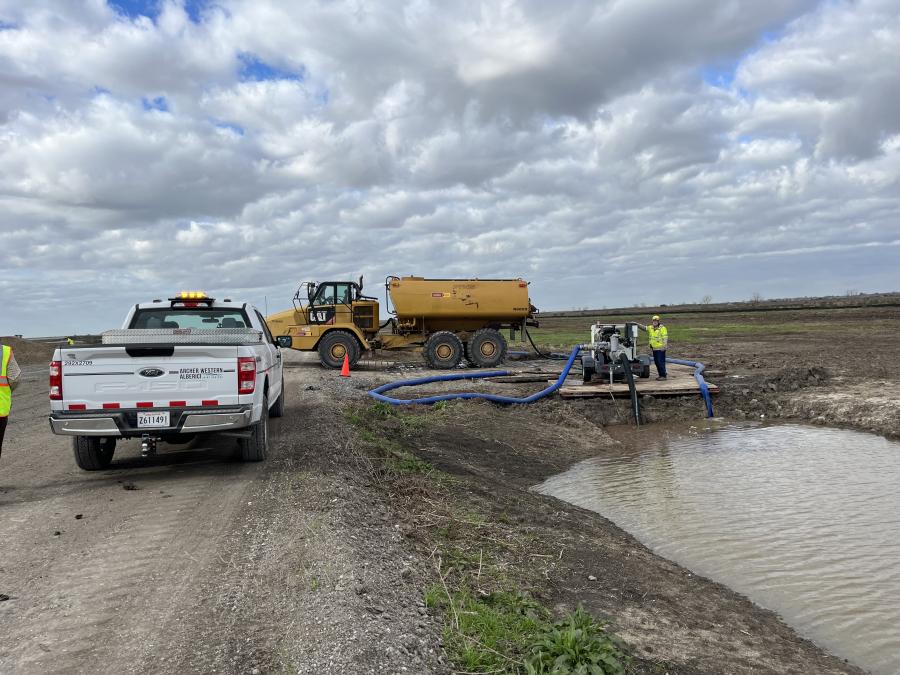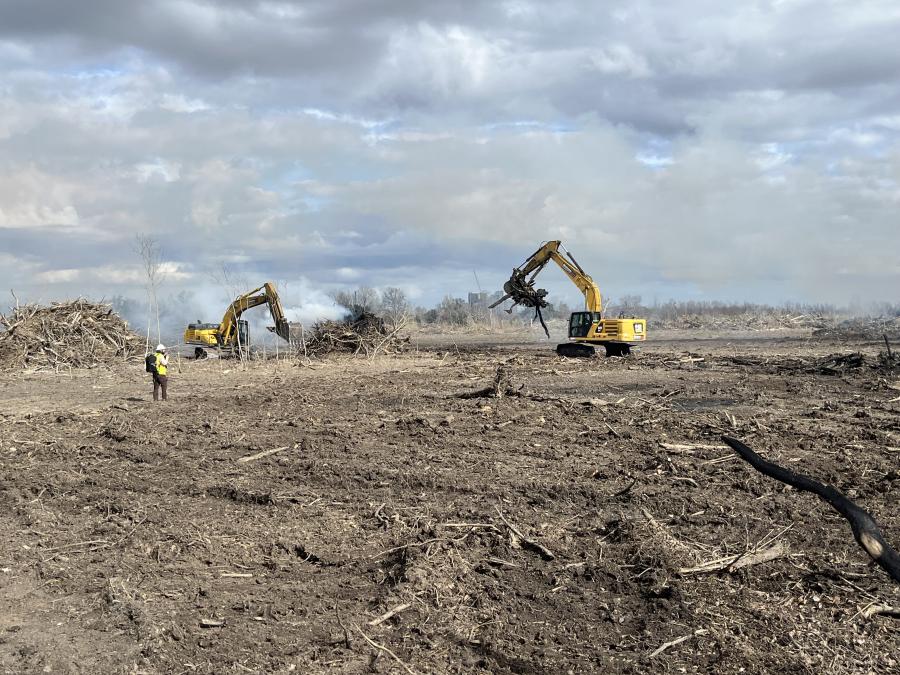Emergent Method photo
Contractors and subcontractors are just beginning to relocate utility lines, grub out vegetation and build access roads. State Hwy 23 has yet to be relocated to where it will cross the project on a new bridge.
Southwest of New Orleans on the west side of the Mississippi River, Louisiana's Barataria Basin has been slowly dying from natural and manmade pressures upon it. The good news is that help is on the way.
Ground has been broken on a nearly $3 billion state government project to infuse the basin with water and sediment from the river. If all goes as planned, in five years, the basin will have billions of gallons of sediment-laden water diverted into it, restoring tens of thousands of acres of land in the process and creating and sustaining upwards of 250,000 acres of wetlands.
"If you look at the history of the lower Mississippi, clear back to the late 1800s and early 1900s, people have been sharing ideas on how to reconnect the river to the basin," Bradley Barth said, giving some background to the project.

Emergent Method photo
Barth is program manager for the Mid-Basin Sediment Diversion Program of Louisiana's Coastal Protection and Restoration Authority. As such, he is the state government's point man on the huge undertaking.
The disconnect of river and marsh partly is a consequence of the success of levees in keeping the Mississippi within its banks. Thus confined, the river can't overflow as easily and replenish the basin's marshes with the sediment and nutrients that floodwaters provide. Manmade channels and development also have played a role.
Natural environmental changes have contributed to the situation, as well, including land settling, or subsidence, as well as rising sea levels and tidal damage.
"There is not just one issue involved. It is multiple issues. Not having the connection to the river doesn't allow the landscape to heal and nourish itself," Barth said.
Today, Baritaria Basin contains, roughly speaking, 150,000 acres of swamp; 170,000 acres of freshwater marsh; 60,000 acres of intermediate marsh; 100,000 acres of brackish marsh; and 130,000 acres of saline marsh. The hope is that five years from now, the ecosystem will have access to a sustainable source of sediment, nutrients and freshwater to heal and nourish itself.
Contractors and subcontractors are just beginning to relocate utility lines, grub out vegetation and build access roads. State Hwy 23 has yet to be relocated to where it will cross the project on a new bridge.
Soon, however, heavy equipment will be hauled in for major earthmoving along the route of the planned diversion channel. The machinery will push up a coffer dam to hold back the river and excavate behind it in preparation for erecting massive flow control structures. When the structures are ready to withstand rushing waters, they will be comprised of 100,000 cu. yds. of structural concrete and 35 million lbs. of strengthening rebar.
The diversion channel is being constructed at a midpoint in the basin, near Ironton, which is south of New Orleans. Most of the injured marsh area lies farther south yet and in the path of the diverted water.
Gates on the east end of the channel will control intake from the river and an outfall structure on the west end will emit the water into the basin's marshland. The manmade channel and levee system will be 1,200 ft. wide. Buffering levees on either edge will rise 25 ft. or so, with a 260-ft. wide strip on the channel bottom carrying the water.

Emergent Method graphic
Two prominent general contractors headline the project — Archer Western of Atlanta, Ga., and Alberici of St. Louis, Mo. An estimated $1.5 billion in economic activity is expected to be generated by the work, including creation of more than 12,000 local jobs.
Most of the nearly $3 billion required for the undertaking comes from a legal settlement with British Petroleum. It followed the Deepwater Horizon 5-million-gal. oil spill in the Gulf of Mexico in 2010.
"That tragedy impacted the basin and led to a lot of land loss," said Barth. "It most definitely impacted the Barataria Basin. It probably was the most impacted of all the areas along the Gulf coast."
Now some of the impact will be reversed.
The Big Muddy obviously comes by its name from all the sediment it carries toward the sea. The success of the project is keyed to the waterborne soil. While some of the moving dirt and clay was stripped from the bottom and sides of the river, much of it is eroded material that washed from fields into tributaries of the river and then into the river itself.
How much dirt are we talking about? Barth — who is a University of Cincinnati-trained engineer with 25 years of experience in Louisiana — calculates that sediment carried into the basin once the channel is fully operational will total some 30,000 to 50,000 tons a year.
"That's the equivalent of 3,000 to 5,000 dump truck loads a day," he said, wryly adding for sports fans, "or 2.4 to 4 million basketballs a day."
Should a reader need yet additional perspective, the engineer and project manager noted that the volume of sediment also equals 14 to 23 acre-ft. of soil per day.
All of this carried-in-and-dumped dirt will produce up to 600 acres a year of dry land rising from the basin's marsh — which, incidentally, is predominantly privately owned. The marsh water on average is only a foot or two in depth, though there are deeper pools. On average, the diverted sediment is expected to raise the elevation of the marsh bottom by anywhere from a half foot to five or six feet. Voila! New ground.
Controlling the velocity of the incoming water is important. Rushing water picks up additional sediment, after all, rather than dropping off the stuff. Water moving too slowly doesn't get to the end of the line. To regulate the flow, engineers will plug in hydraulic data about flow — width, depth, contour of the terrain — and then move the river water at an optimum pace for new delta-building.
The ultimate destination for the water is the Gulf, which of course is the same place the river ends up. The difference is the diverted water will have performed three functions before getting there — restoring land, freshening brackish pools of water and invigorating growth of native vegetation. While the project has no salinity reduction goals, some brackish and salty water will be diluted by the diverted water.
The muddiness of the water before the soil is dropped is not a threat to flora or fauna, according to Barth. To the contrary, he cites another area on the east side of the Mississippi River where the moving water regularly spills out into a marsh.
"There is an enormous amount of vegetation growth there," said Barth.
The diversion process will have a negative impact on some marine species, including oysters and brown shrimp, that are at home in brackish water. On the other hand, freshwater bass among others are expected to benefit immediately. Long term, the overall habitat for fish and vegetation will be generally enhanced by the infusion of river water and sediment. Still, some funds have been set aside to mitigate any near-term impact from the diverted water for affected businesses and properties as well as fishery resources.
This is the heart of hurricane country, of course, Katrina being a never-to-be-forgotten one in and around New Orleans. The reinvigorated marshes and emergence of new land amid the water are not unrelated to the storms.

Emergent Method photo
"The more land and marsh we have between the gulf and levees helps our communities," said Barth.
Earthen structures aren't the only defense against a storm's fury.
"The marsh in front of the levees helps reduce storm surge and, especially, waves. It helps hold the sea water at bay," he said.
For the next five years of diversion channel construction, the additional protection won't yet be in place. The project will be at the mercy of hurricane season, from June to November.
"Our completion schedule does not include hurricane delays," Barth said. "We are very likely to experience something like that and we have planned accordingly. I would like to tell you we have thought of everything, but there will be stuff that comes up. Storms and other things that will surprise us. But for me, it is making sure we have the right team members in place to meet any challenge that comes." CEG
Today's top stories



























